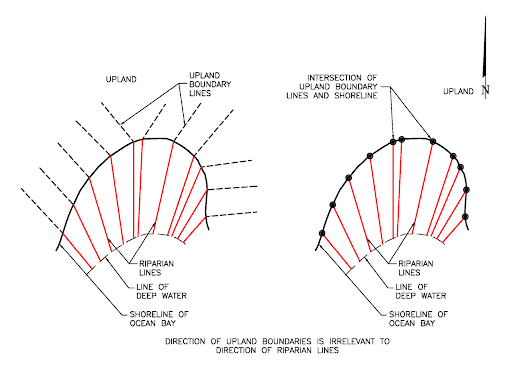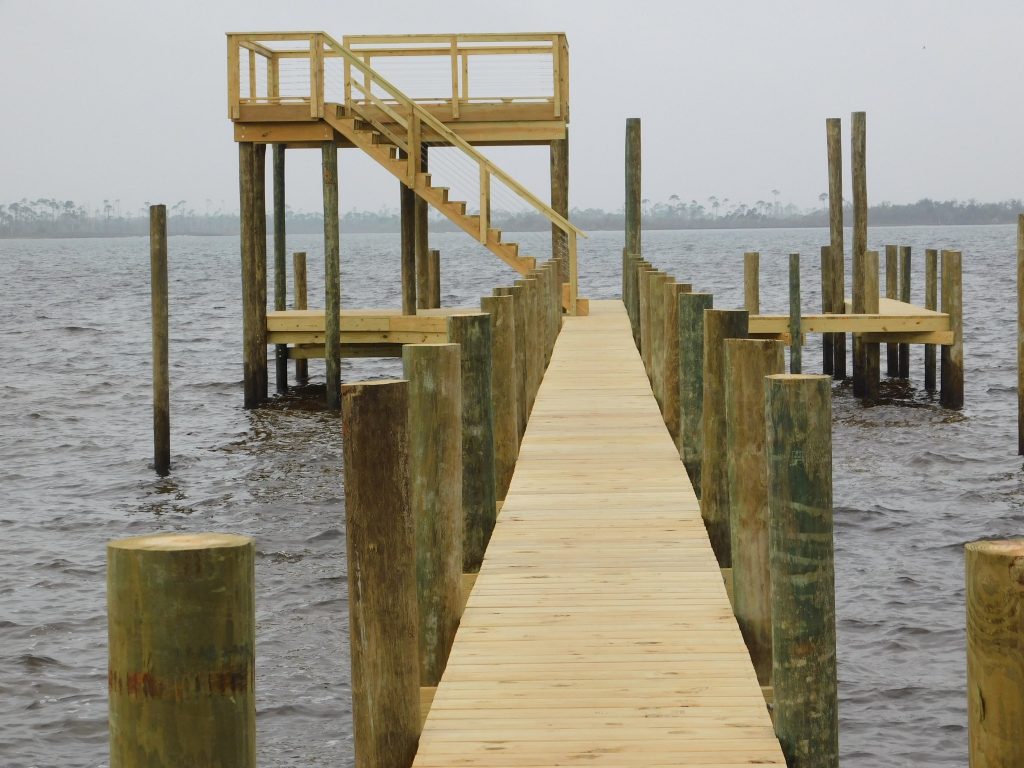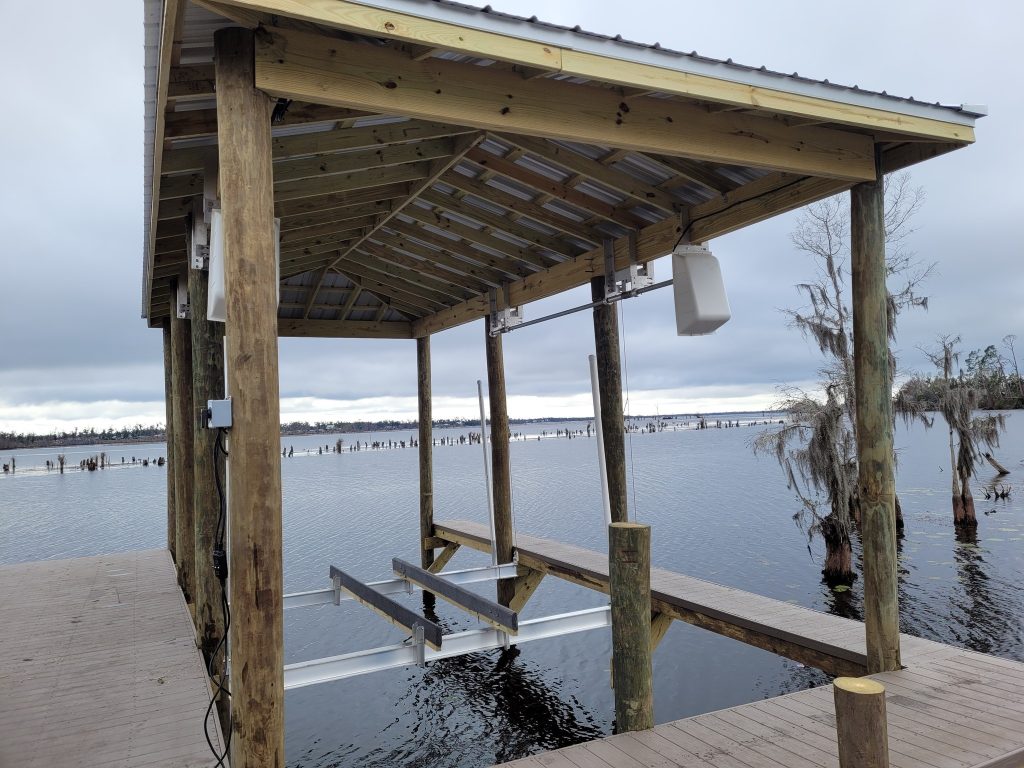Anytime I’m faced with a big job that I’m unacquainted with, I often get “paralysis by analysis”. Building a dock is one of these jobs. From permitting and regulations to design and structural integrity, dock construction can seem like a daunting task, especially if you’re unfamiliar with where to begin. On Episode 205 of Northwest Florida Fishing Report, I recently interviewed seasoned dock builder Ryan Vess, partner at Art Marine, to discuss this topic in detail. Give it a listen if you are looking for all of the nuances. In this article, we’ll break down the essential points to consider before starting dock construction.
Understanding The Map Is Integral To Dock Design
Before diving into dock construction, it’s crucial to assess your property. Every property is unique, and some factors are different for each property that can dictate what you are allowed to construct.
One of those factors is the mean high water line (MHWL), which some people refer to as their waterfront distance. NOAA defines this as the line on a chart or map that represents the intersection of the land with the water surface at the elevation of mean high water. Where this comes into play is with dock setbacks. In most coastal areas, a MHWL of less than 65 feet does not require any setback limitations, whereas a MHWL of greater than 65’ does. This crucial bit of information can drastically affect how you can design your dock.
Another key point to understand is your riparian lines. Many waterfront landowners assume that their riparian lines extend into the water in the same direction as their upland boundaries. This is not always the case. Disregarding riparian lines and the MHWL distance is a great way to end up in a dispute with your neighbors or run afoul with the regulating authorities. Different regions may have varying regulations, so it’s essential to understand local requirements.

Budgeting When Building a Dock
Budgeting for dock construction can be challenging, considering the numerous factors involved. Costs can vary widely on materials and labor, and it’s easy to forget the costs of additional features like boat lifts, electrical, plumbing, and roofing over boats. I believe that the best way to approach budgeting is to design your dream build and find out what that costs, and then if that is outside of your budget, work with your builder to learn how you can bring the cost down. Maybe you don’t need the entire dock built right now? Planning the construction in phases can space out the costs and allow you to get what you want over time instead of having to go cheap.
Material Selection
Choosing the right materials is often a compromise between cost and durability. Treated pine decking, for example, will be less expensive on the front end compared to composite decking. Marine pressure-treated pilings won’t last as long as composite pilings, but that comes with a cost, and you may be able to meet in the middle by using a piling wrap that will mitigate wood pests. Galvanized hardware will be less expensive than stainless hardware, but it will also corrode and need to be replaced sooner. Each material comes with its pros and cons, impacting both cost and maintenance requirements. Ultimately your choice of materials will be unique for your budget and goals.

Dock Building Structural Integrity
Structural integrity is paramount, especially in areas prone to storms and harsh weather conditions. To be able to withstand potential challenges, such as hurricane-force winds and waves, your boat dock needs to be “overbuilt”. “When I go and look at a dock, I’m looking at how strong I can build it. So when a bad storm comes through, I don’t get embarrassed,” says Ryan Vess. There are several key areas to pay close attention to.
Boat Dock Pilings
Proper piling installation and reinforcement techniques play a crucial role in ensuring the dock’s stability. Ryan had this to say about piling installation, “The big deal with pilings is getting them down deep. For every dock that I build, I water jet at least 10’ depth and then I drop a big 300-pound hammer on it to drive it to completion. Then I build it with triple bolts in each piling.”
Boat Houses
Many boat dock builders want a boat house to shelter their watercraft from rain and UV rays. “You always ride around and you see sagging boathouses, one of the pilings will be low, they got a boat lift in there and the center’s low because the boat center of gravity was set wrong.” Ryan said. “When we get to the building and the strength, I build a triple 2X12 band around my boat houses, and all you’re required to do is pretty much a double 2×12. I use ten-inch butt pilings, most people will use nine-inch because they’re easier to handle and they’re cheaper. I set my pilings roughly seven and a half feet on center. You can make your dock last longer, you just add five extra boards or four extra pilings and it’s gonna make it through a big storm a lot better than a dock built with less.”

Boat Dock Roofing
We’ve written about roof building to withstand hurricanes before, the summary is this: While asphalt shingles provide a low-cost option for builders, the Gulf Coast’s frequent damaging winds make them an inferior choice for roofing material that will likely cost you more in the long run. In addition to the type of metal roofing, you must take into account the design of your roof when building. Jason Norton, president of Baker Metal Works and Supply, a major Gulf Coast supplier of quality metal roofing from Dixie Building Supply, had this to say when asked about fortifying roofs here on the Gulf Coast, “Many factors go into calculating if a specific metal roofing product will work. Roof slope, wind exposure category, and design wind speed for the actual house location must be considered. The first thing that someone seeking fortification should do is get with a local engineer/architect to see if the product you are interested in fits all the criteria for your specific location.”
Final Thoughts Before You Begin
Building a dock requires careful planning and consideration of various factors, from property assessment to material selection and construction techniques. If you’re planning to use a builder, make sure to educate yourself on what is required of you in addition to what the “best practices” are in the construction of each element so that you not only get the value you are looking for from your build but can enjoy your boat dock for years to come.




